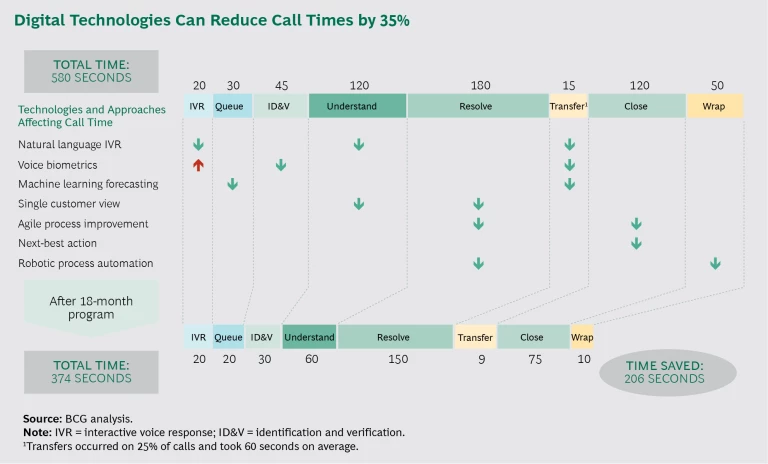This is the first in a series of articles on the digitalization of customer contacts.
Even in the digital age, the outlook is bright for contact centers staffed by people. To be sure, more and more interactions between consumers and companies are taking place on digital channels, and smart machines are poised to take on all sorts of contact-related tasks that today require human agents. But contact centers are not about to go the way of the steno pool, passing into business history.
Indeed, even as digital touch points multiply and contact center volumes fall, human agents can become more important as a source of value for consumer-facing companies, helping them compete on customer experience at a time when core products and services—such as flight bookings or checking accounts—may be viewed as commodities. Deploying agents in new, higher-value ways is a key element in an overall strategy to use digital tools to improve customer contact, whether human-to-machine or human-to-human.
Rather than forcing contacts onto digital channels to cut costs, best-practice companies are looking at where digital contact works and where human contact is more effective, and creating seamless handoffs between the two. The model that’s emerging is what we call the virtual customer relationship center. Implementing this model will require new skills as well as new technologies. But companies that do this right can improve the customer experience, capture savings, and create new sources of revenue.
The March of Digitalization
Advances in digital technologies will make it possible to automate more contacts and tasks that human agents now perform. Technology will also help companies better manage contacts—both human-to-machine and human-to-human. The net impact will be to blur the line between digital and human touch points. Agent contacts—through customer service help lines, for example—will be tightly integrated with digital touch points such as mobile apps, social networks, and online communities. All of these contacts can be monitored and analyzed to improve the customer experience and create new sales opportunities. Data analytics can tell companies which kinds of contacts are most effective for resolving specific issues and where adjustments are necessary. Or by combining transaction data and customer profile data—products used, customer lifetime value, social media activity, demographic data, and so on—companies can create custom deals for upselling or cross-selling that have a better chance of succeeding than one-size-fits-all offers.
Here we look at two kinds of technologies: those that are used in digital channels and those that can improve the efficiency and effectiveness of contact center operations. To get the most benefit from these technologies, companies should implement them as part of an overarching service design, rather than in a piecemeal fashion.
Technology for Digital Channels. New apps and back-end technologies are making human-to-machine contact much easier for people and more productive for companies.
- Visual IVR. The near universal adoption of smartphones means that visual interactive voice response (IVR) systems can eliminate the frustration of telephone-based systems, which ask callers to remember the correct number choice for their issue. With visual IVR apps, the choices are spelled out clearly on buttons on the screen, so customers do not have to listen to a menu. They can find their way to the right channel to get their problem resolved: voice, self-serve, chat, or a combination. If a customer gets stuck, an agent can look at the same display and guide the customer through a self-serve interaction. With visual IVR, there are fewer instances of misrouting—and less frustration for customers, who will no longer have to punch every button until they finally get an agent.
- Chat. Chat is an increasingly popular contact channel. Using seamless handoffs within apps or on websites, customers connect with agents, who type responses to their questions. Although these interactions can take longer than a voice call, an agent may be able to handle multiple queries simultaneously, and customers are often happy to multitask as they wait for an agent’s response. A good chat function can help keep customers in digital channels, lowering contact center costs. Chat interactions can also be easily routed to low-cost locations, where agents who do not have top language skills can still answer questions. Chat also provides a way to seamlessly incorporate bots into the contact center mix, reducing the need for human interaction. When the system sees a query that can be answered by a bot, the contact can be automatically switched to a bot and then back to a human, as needed. Chat also provides a platform to steer questions to digital channels or offer enhanced service—sending a caller an illustration, a brochure, or a link to an instructional video, for example. The chat channel needs to be planned and implemented carefully: hastily implemented chat, with poor service levels and highly scripted responses, can damage the customer experience.
Chat provides a way to seamlessly incorporate bots into the contact center mix.
- Analytics. Predictive and proactive analytics make it possible to stitch together customer behavior information from touch points in every channel, giving the company a complete picture of a customer’s journey. Combining this analysis with internal and external data on the customer, companies can respond with personalized solutions to immediate customer needs (often before the customer reaches out) and predict future needs (which could translate into sales). Data analytics can also provide insights for continuously optimizing customer journeys, helping companies make the digital channel easier to use and, increasingly, the channel of choice.
Technology to Improve Contact Center Operations. Digitalization can offload tasks such as customer verification from agents, extend agent capabilities, and improve the customer experience, while increasing efficiency and effectiveness. A typical configuration of these technologies can reduce call times by 35%. (See the exhibit.)
- Voice Biometric Authentication. Instead of having an agent ask for identification data, the computer verifies the customer’s identity using voice biometric programs that check pre-recorded “voice prints.” (A customer records a voice print in the company’s system by following prompts.) This enables the agent to start giving answers as soon as the customer is connected, rather than spending 20 to 45 seconds walking the caller through verification scripts. Voice biometrics also strengthen security because callers no longer must share passwords or personal data over the phone. Banks, such as HSBC, started to adopt this technology in 2016; it is now spreading to other industries.
- Natural Language Processing. NLP is used to analyze calls and quickly understand a customer’s intent and mood. This information can be used to improve customer experiences, both in the center and at earlier points in the journey.
- Smart Routing. This technology matches a customer to the best group of agents to resolve the issue on the basis of customer attributes and the type of query. Tech support calls from older consumers, for example, can be sent to teams with special skills in helping such customers. Smart routing can also help move a customer who has made contact through an app—and whose identity therefore has already been verified—seamlessly to the best-equipped agent.
- Robotic Process Automation. RPA offloads routine data entry tasks from agents, potentially saving 10 to 30 seconds per call. Robotic software enables rapid automation of repeatable processes, quickly achieving 40% to 60% of the benefits of fully integrating the back ends of multiple automated systems. Full back-end integration eliminates the need to transfer data between systems, but it can take many months or even years to complete the integration.
- Cloud Infrastructure. Call routing and telephony infrastructure as well as customer relationship management (CRM) systems sit in the cloud (rather than in a data room in the center facility). This allows greater flexibility in scaling capacity up and down and makes it easy to route a customer contact to the most logical place—whether it is to a 1,000-seat center in Manila, an office building in Manchester, or a home office in rural Manitoba.
Additionally, several noteworthy technologies that improve contact center operations, all related to artificial intelligence, are on the horizon. AI is already being applied to a few areas in centers. Within five years, we expect smart machines to take on a wider range of self-service activities and increasingly complex tasks. We estimate that the following emerging technologies could reduce the demand for labor by 50% to 60% by 2022.
- Advances in cognitive computing will create digital contact systems that can accurately and independently respond to complex queries or channel them to the right team member.
- Virtual assistants, such as Alexa, Google Now, and Siri, can play a role in customer contact—for example, by connecting a consumer to multiple departments within a company or even to multiple companies to solve a problem.
- Intelligent agents will sit alongside human agents, “listen in” on conversations, and augment human capabilities with rapid access to answers and advice. In addition, intelligent agents can take care of follow-up work, such as sending out a loan application, so that the human agent can get to the next call.
- Some companies are applying a combination of customer data and personality tests to experiment with matching individual customer “character” to individual agent “character.” The theory is that stronger rapport will increase customer satisfaction and even sales conversion. Early adopters are working their way through initial side effects. For example, better-performing employees may perceive that they are presented with the more “difficult” calls.
- Machine learning algorithms will automatically adjust and test business processes to continually improve customer experience.
The Rise of Digitally Enabled Agents
Advanced technologies in the virtual customer relationship center will transform the work of human agents. Technology will not only offload repetitious and routine tasks but also give agents new capabilities. There may be fewer agents in the contact center, but they will have more skills and take on more important work. Agents will be there when companies need to respond to a problem before there’s time to reprogram a computer. They’ll be there when customers need to talk to a person—to know someone is listening, to hear a note of kindness or a joke about the weather. Most important, they’ll be there to handle the most challenging customer problems, prevent the loss of at-risk customers, and generate sales by ascertaining customers’ needs. Agents are uniquely positioned to increase value per customer (that is, share of wallet), save faltering customer relationships, and increase brand engagement and consideration.
There may be fewer agents in the contact center, but they will have more skills and take on more important work
One of the best opportunities for agents to add more value is in matching additional products and services to customers’ needs. Using data analytics, for example, centers can now customize offers that agents can work into the conversation. Every offer can be based on detailed knowledge of the customer’s habits and history with the company. Centers can test and analyze various approaches to determine which offers and messages elicit the best responses. Data analytics can also create better incentives for agents—basing their rewards on improving value per customer rather than on the number of items sold, for example. Done right, these service-to-sales approaches can generate revenue that covers 15% to 30% of center costs.
This extraordinary opportunity also comes with considerable challenges, particularly for centers that have been managed for cost above all. Most organizations today lose sales opportunities in the contact center because they use “inside-out” targets rather than understanding and responding to customers’ needs and striving for service excellence. Companies also make the mistake of treating all agents as potential sales reps; some people do not have the sales gene and should be encouraged to build other skills. Management should identify and cultivate sales talent in the contact center and devise processes to route calls that have potential for upselling or cross-selling to those agents.
There are more opportunities to open a sales conversation than many companies realize. But the right talent must be on the line with the right competency at the right moment. Calls in which the agent is able to provide expert knowledge or help a customer with a decision are obvious door openers. But a conversation that stems from a service failure can also turn into a selling opportunity. If the agent has the skill to solve the problem and has treated the customer well, the customer may be grateful and open to a sales idea.
A conversation that stems from a service failure can turn into a selling opportunity.
Pursuing Continuous Operational Improvements
To give digitally enabled human agents everything they need to succeed, companies must aggressively pursue continuous operational improvements. Virtual customer relationship centers enable companies to measure performance and use data to that end. This effort applies to agent work as well as digital contacts: even as they digitalize more contacts, most companies can make significant gains in operational performance in contact centers. Indeed, best-practice companies are establishing an operating rhythm for the data reviews and other processes that drive continuous improvement. Five steps are critical:
- Understand shifting customer demand. Digital will likely reduce overall demand for human agents but will create new and more complex types of interactions, which will require new ways of managing. One challenge is to develop strategies to cope with unpredictable spikes in demand when digital channels go down. Digital systems in the center will be able to help manage demand by automatically assessing customer needs and determining whether contact with an agent is required or the issue can be resolved through a self-serve system.
- Use advanced analytics for forecasting and scheduling. With leaner center operations, there is less margin for error in scheduling contact center staff. At the same time, centers must accommodate traffic coming in from multiple channels, even as agents engage in more-complex interactions, which means call times may be longer. This all affects staffing requirements, particularly during periods of peak demand. Using data analytics, centers can probe the variables and refine scheduling for time of day and time of year, and even anticipate some surges in demand. With cloud platforms, companies can manage center capacity dynamically. Agents can be reassigned virtually to other centers to balance workloads or calls can be seamlessly routed to agents with specialized knowledge.
- Optimize operating models. The rise of digital channels and the evolving virtual customer relationship center model change the calculus for deciding what to keep in-house and what to outsource. Companies should take stock of their capabilities and identify where they can build a strategic advantage in-house and where they should work with partners. Given the enhanced skills that agents will need in the virtual customer relationship center, companies should also rethink how they decide which types of contact to outsource. Centers may need fewer agents, but those they hire will need to be more highly educated and to have special skills, such as proficiency in multiple languages. So hourly labor rates may be less of a determining factor when making outsourcing decisions. As companies digitalize more customer contacts and automate contact center tasks, they should also think about which locations are best for strategic contact work and which might be candidates for consolidation.
- Upgrade back-end systems. In addition to front-line technology, such as robotic process automation and voice biometrics, the virtual customer relationship center requires robust back-end technology infrastructure. This includes reliable and flexible telephony management, systems to consolidate customer data, and tools to manage processes and quality.
- Manage multiskill, multichannel talent. For contact centers to focus on the most complex customer interactions, including opportunities to upsell and cross-sell, talent must be nurtured, managed more effectively, and given new opportunities. Agents will need to do more listening and problem solving—even as they guide callers to digital channels. This has implications for hiring and training practices. In addition, centers should take advantage of every agent’s capability “spikes”—if an agent is particularly good at technical information, management should arrange for that agent to spend 60% to 70% of his or her time answering technical questions.
As companies plot customer journeys, they should not underestimate the power of multichannel contact with customers. The proliferation of digital channels is multiplying the opportunities for contact. Data analytics give companies the insights to tailor every response to a customer’s query for optimum results. Every contact is an opportunity, and every type of contact—especially with a human agent—can help shape satisfactory and productive journeys. Because none of these changes should be treated as an independent development, the virtual customer relationship center lies at the heart of the digital transformation.










